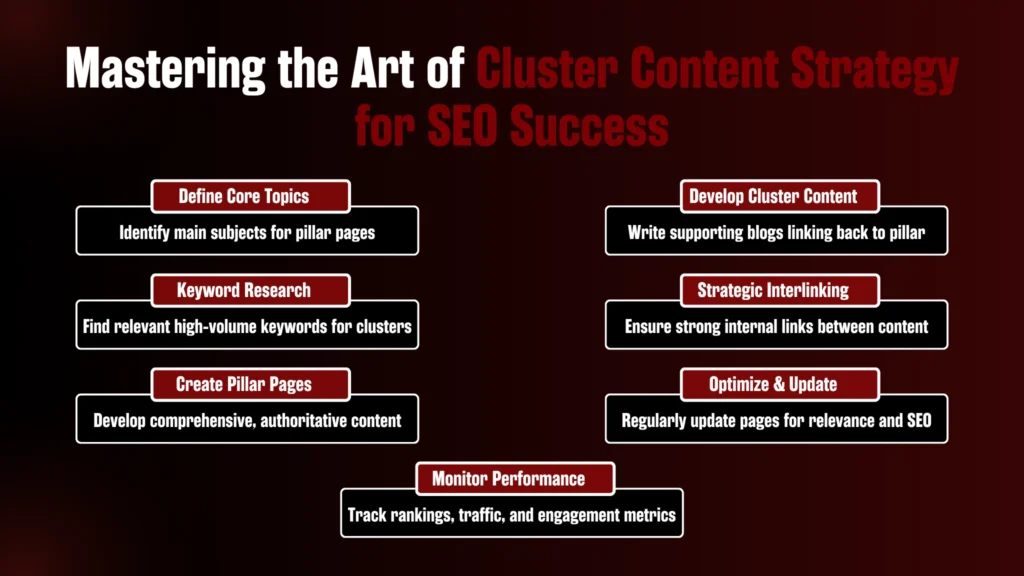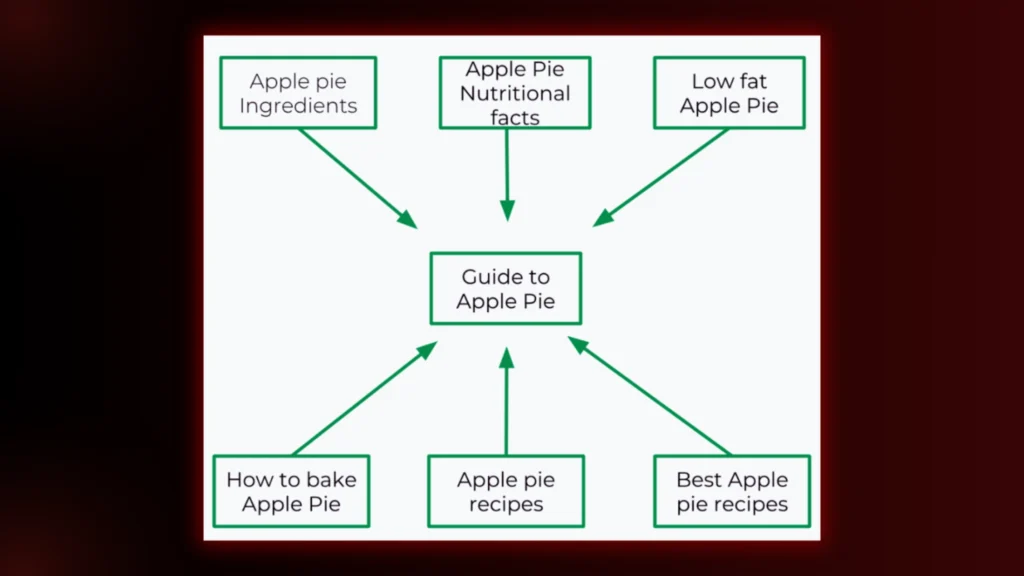If you’re looking to take your content marketing game to the next level, adopting a cluster content strategy is your golden ticket. This method not only helps you rank higher on search engines but also establishes your authority in your niche by delivering value-packed, interconnected content. Let’s dive deep into what this strategy entails, why it’s a game-changer, and how you can implement it to transform your digital presence.

What Is a Cluster Content Strategy?

At its foundation, a cluster content strategy is regarding grouping similar content pieces together based on the central theme. This includes the following:
- Pillar Pages: Authoritative pages that will be broad and comprehensive as a central resource for a given topic
- Cluster Content: Supporting blog posts or pages that expand into more detail about a subtopic to the pillar page.
- Internal Links: The connections between the pillar page and the cluster content to link everything together in the web of the information.
You can think about this approach like you are producing a library, with the pillar page being the primary book on a subject matter, then the cluster content acts like chapters or ancillary material to the source material. You are improving the user experience while also conveying to the search engines that your site is a knowledgeable resource on a given subject matter.
Why Does Cluster Content Strategy Matter?

Content is everywhere online — over 1.9 billion websites compete for our attention every day. Content changes quickly, so to be different, you don’t just want high-quality articles, you want a content strategy that aligns with the current algorithms Google uses to rank stuff.
Here’s why cluster content strategy is essential:
1. SEO Rankings Boost: When you link a lot of relevant pages and the relationship between them, it makes it very easy for search engines to get a clearer picture, and this may help in the advancement of the ranking of your content.
2. Enhances User Experience: When the visitors can easily jump between related topics, they will spend more time on your site.
3. Avoids Keyword Cannibalism: Rather than fighting against yourself over similar keywords, you create authority for one pillar page.
4. Showcases the Expertise: An organized cluster displays your expertise in [niche] to the users as well as google.
How to Build a Cluster Content Strategy
Identify Your Core Topics
Make a list of topics. These would become your pillar pages. For example:
An example could be a fitness website with pillars such as “Weight Loss,” “Strength Training,” and “Nutrition.”
Conduct Keyword Research
Similar high search volume and relevance keywords can be found using the Google Keyword planner or Ubersuggest. KPI (Keywords – assign these to your pillars and clusters)
Create Pillar Pages
Create long-form, all-encompassing pillar pages targeting a particular subject at a high level but covering it in detail. For instance:
For example, a pillar page on “Weight Loss” may consist of sections on diet plans, exercise routines, sleep importance, and stress management.
Develop Cluster Content
Develop a set of supporting articles around sub-topics related to the pillar theme. For example:
Potential cluster articles for “Weight Loss” might be:
“10 High Protein Breakfasts to Drop Pounds”
“The Role of Sleep in Weight Management”.
Interlink Strategically
Interlink relevant pieces of cluster content within an overall theme and pillar page and the other way around. Thus, creating a tightly-knit network, improving both navigation and SEO.
Optimize Existing Content
Conduct an audit of your existing blog posts to see which ones can be repurposed or updated to fit into your clusters. Add internal links and optimize for your target keywords
Monitor Performance
Tools, like analytics, can help track performance metrics such as organic traffic, bounce rates, and search engine keywords rankings for each cluster. Tune your strategy based on what works best
Best Practices for Cluster Content Strategy
To maximize results, keep these tips in mind:
- Put Quality Over Quantity: Confirm that every piece of content should offer value and answer user questions.
- Update Regularly: Pillar pages should remain relevant by adding new facts and keeping the pages fresh.
- Use Different Formats: Include videos, infographics, podcasts, or social media shorts, alongside written blogs, for some diversification.
- Focus on Intent: Focus on what users are searching for rather than just throwing in keywords.
Examples of Successful Content Clusters
Let’s look at some real-world applications of this strategy:
1. Zapier’s Remote Work Guide:

- Pillar Page: “Ultimate Guide to Remote Work”
- Clusters: Articles on productivity tools, remote team management, and work-life balance.
2. Fitness Website Example:

- Pillar Page: “Strength Training Basics”
- Clusters: “Best Dumbbell Workouts,” “Strength Training for Beginners,” “Common Mistakes in Weightlifting”.
3. Fashion Blog Example:

- Pillar Page: “Sustainable Fashion”
- Clusters: “Why Fast Fashion Is Harmful,” “Top Ethical Clothing Brands,” “How to Build a Capsule Wardrobe”.
These examples highlight how diverse industries can leverage cluster strategies effectively.
Common Mistakes to Avoid
Although creating a cluster content strategy is simple enough, there are traps you want to avoid:
- Keyword Stuffing: Instead of stuffing your content with keywords, focus on natural language and natural flows.
- Not Internal Linking: Your clusters don’t work for SEO if not interlinked properly.
- Ignoring Analytics: Not tracking performance means you won’t know what’s working, and what’s not.
- Building Weak Pillar Pages: Your pillar is not authoritative or comprehensive enough to attract backlinks and rank.
Benefits Beyond SEO
While SEO gains are often the primary motivation behind adopting a cluster content strategy, there are additional advantages:
1. Improved Brand Authority:
– Organizing your content into clusters positions you as an expert in your field
2. Better Audience Engagement:
– Visitors are more likely to explore multiple articles when they’re interconnected.
3. Streamlined Content Creation:
– Having defined clusters makes it easier to brainstorm new topics.
Final Thoughts
A well-executed cluster content strategy is more than just an SEO tactic—it’s a roadmap for delivering value-packed content that resonates with both users and search engines alike. By organizing your website into interconnected pillars and clusters, you’ll not only improve rankings but also establish lasting authority in your niche.
So why wait? Start building your own cluster content strategy today with BrandClickX and watch as it transforms your digital presence!
Contact us to discuss more!
FAQs
What is the primary goal of implementing a cluster content strategy?
The primary goal of a cluster content strategy is to organize related content around central topics, enhancing user experience and improving SEO rankings by showcasing expertise and authority in a specific niche.
How does a cluster content strategy help with SEO?
A cluster content strategy aids SEO by creating a network of interconnected content that helps search engines understand the depth and breadth of your expertise, leading to better rankings and visibility.
What are the key components of a cluster content strategy?
The key components of a cluster content strategy include pillar pages (central topics), cluster content (supporting articles), and strategic internal linking to connect these pieces for enhanced user navigation and SEO benefits.
Can a cluster content strategy be applied to any industry?
Yes, a cluster content strategy can be applied to any industry. It is versatile and effective in organizing content to showcase expertise and improve online visibility across various sectors



